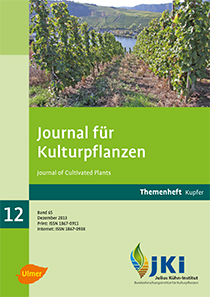A simple model of possible copper contents in earthworms using model soil extracts from old vineyards; a comparative assessment of NH<sub>4</sub>NO<sub>3</sub> and CaCl<sub>2</sub> extracts
DOI:
https://doi.org/10.5073/JfK.2013.12.03Keywords:
Copper, vineyard soils, Plasmopara viticola, earthworm monitoring, bioavailability to soil organisms, bioconcentration factor, copper loads, exposure, risk assessment, pathway soil/soil organisms, comparison of two model extractionsAbstract
Copper contents assessed in an NH4NO3 extract and CaCl2 extract were determined to evaluate their impact on soil fertility using earthworms as indicators of sustainable agriculture and the maintenance of biological diversity. The final evaluation can be conducted when the field surveys on the earthworm coenose have been completed.
So far, the surveys have covered the earthworm coenoses of 15 vineyards. The obtained data were used in a simplified approach to find out whether it is possible to perform a risk assessment on available copper in model extracts for the pathway soil/soil organisms in soils under organic or conventional management. The small sample size (n = 49) does not allow for a final evaluation at present. It is, however, possible to see tendencies.
The area values evidenced a high correlation of R2 ~ 0.79 between the copper content in the NH4NO3 extract and the quotient of total content in soil organisms divided by the content in the soil extract (bioconcentration factor – BCF) of the earthworm coenose. However, the correlation of earthworm-available copper in the CaCl2 extract with the BCFs of the earthworm coenose calculated for each area resulted only in a mean coefficient of R2 ~ 0.52.
The use of BCFs has the advantage that all factors responsible for the availability of copper at a given site are reflected by the actual copper contents in an earthworm coenose and are included in the model through the extract contents.
The results obtained so far support the use of the NH4NO3 extract as an appropriate model to predict copper contents in earthworm coenoses of vineyards with long-term treatment. The exposure data collected from field surveys and the percentage of mobile copper can be subjected to simple regression analysis to perform a first assessment of the risk potential of copper in the pathway soil/soil coenose and accumulation in the earthworm coenose.
When the total content does not exceed ~ 300 mg Cu kg–1 soil (TM), copper was found to accumulate in lumbricidae only to a limited amount. This indicates the adaption of soil organisms to site conditions.
The modeling of possible copper contents in soil quality indicators requires further surveys of earthworm coenose further evaluate which extraction procedure is appropriate to determine the copper content in organisms suitable for risk assessment.
Downloads
Published
Issue
Section
License
The content of the journal is licensed under the Creative Commons Attribution 4.0 License. Any user is free to share and adapt (remix, transform, build upon) the content as long as the original publication is attributed (authors, title, year, journal, issue, pages).
The copyright of the published work remains with the authors. The authors grant the Journal of Cultivated Plants, the Julius Kühn-Institut and the OpenAgrar repository the non-exclusive right to distribute and exploit the work.







